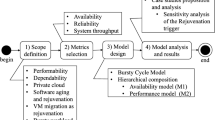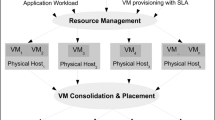Abstract
Software aging affects the availability of Virtual Machine Monitor (VMM), one of the main components of virtualized environments. Software aging causes internal software degradation due to bugs activation and accumulation during its execution. Software rejuvenation implemented through Virtual Machine (VM) Live Migration may be applied to cope with software aging effects on cloud computing system. Another relevant problem is the power consumption of using software rejuvenation techniques in the virtualized environments. This paper presents availability models based on Stochastic Petri Nets to evaluate two VM Live Migration approaches. These approaches are based on the redundancy schemes: Warm-Standby and Cold-Standby. In the Cold-Standby migration, the migration target machine is started only before the VM Live Migration. In the Warm-Standby Migration, the migration target machine runs along with the source migration machine. Results show that VM Live Migration causes a significant improvement in system availability. Scenarios with a heavy workload present an annual downtime reduction of 164 h. The availability comparison between two approaches reveals that the Cold-Standby approach has a slightly better result due to the decrease in the total number of VM Live Migrations. The power consumption results show that Cold-Standby approach is more efficient in power consumption. In all the observed scenarios, the costs savings by using Cold-Standby approach exceed 40%. The highlights of this paper are: i) a comprehensive model for availability evaluation of cloud computing with VMM rejuvenation through VM migration scheduling; ii) sensitivity analysis to define proper rejuvenation scheduling to maximize system availability and iii) power consumption comparison of the two adopted migration approaches.













Similar content being viewed by others
Notes
CS PA \(\rightarrow \) Cold-Standby Migration peak availability, WS PA \(\rightarrow \) Warm-Standby Migration peak availability.
Dell Server PowerEdge 1850 with two Xeon 800FSB processors, 8 GB of RAM.
Abbreviations
- CRAC:
-
Computer Room Air Conditioner
- PM:
-
Physical machine
- SPN:
-
Stochastic Petri Net
- SRN:
-
Stochastic Reward Net
- TTARF:
-
Time to Aging-Related Failure
- UPS:
-
Uninterruptible Power Supply
- VM:
-
Virtual Machine
- VM:
-
Virtual Machine Monitor
References
Araujo J, Matos R, Maciel P, Matias R, Beicker I (2011) Experimental evaluation of software aging effects on the eucalyptus cloud computing infrastructure. In: Proceedings of the Middleware 2011 Industry Track Workshop, p 4. ACM
Araujo J, Matos R, Maciel P, Vieira F, Matias R, Trivedi K (2011) Software rejuvenation in eucalyptus cloud computing infrastructure: A method based on time series forecasting and multiple thresholds. In: 2011 IEEE Third International Workshop on Software Aging and Rejuvenation (WoSAR), pp 38–43. https://doi.org/10.1109/WoSAR.2011.18
Ataie E, Entezari-Maleki R, Rashidi L, Trivedi KS, Ardagna D, Movaghar A (2017) Hierarchical stochastic models for performance, availability, and power consumption analysis of iaas clouds. IEEE Trans Cloud Comput
Baccarelli E, Amendola D, Cordeschi N (2015) Minimum-energy bandwidth management for qos live migration of virtual machines. Comput Netw 93:1–22
Beloglazov A, Buyya R (2010) Energy efficient allocation of virtual machines in cloud data centers. In: 2010 10th IEEE/ACM International Conference on Cluster, Cloud and Grid Computing (CCGrid), pp 577–578. IEEE
CDW: Cdws cloud 401 report. Report, CDW (2015)
Chang X, Wang T, Rodrguez RJ, Zhang Z (2018) Modeling and analysis of high availability techniques in a virtualized system. Comput J 61(2):180–198. https://doi.org/10.1093/comjnl/bxx049
CISCO: Cisco global cloud networking survey summary and analysis of results worldwide results. Tech. rep., CISCO (2012)
Clark C, Fraser K, Hand S, Hansen JG, Jul E, Limpach C, Pratt I, Warfield A (2005) Live migration of virtual machines. In: Proceedings of the 2nd Conference on Symposium on Networked Systems Design & Implementation-Volume 2, pp 273–286. USENIX Association
Cotroneo D, Natella R, Pietrantuono R, Russo S (2014) A survey of software aging and rejuvenation studies. ACM J Emerg Technol Comput Syst (JETC) 10(1):8
Dantas J, Matos R, Araujo J, Maciel P (2015) Eucalyptus-based private clouds: availability modeling and comparison to the cost of a public cloud. Computing 97(11):1121–1140
Dell datacenter capacity planner tool (2017). URL http://www.dell.com/html/us/products/rack_advisor_new/index.html
de Melo MDT, Araujo J, Umesh I, Maciel PRM (2017) Sware: an approach to support software aging and rejuvenation experiments. J Adv Theor Appl Inform 3(1):31–38
Dohi T, Goseva-Popstojanova K, Trivedi KS (2000) Statistical non-parametric algorithms to estimate the optimal software rejuvenation schedule. In: 2000 Pacific Rim International Symposium on Dependable Computing, 2000. Proceedings. IEEE, pp 77–84
Dohi T, Goševa-Popstojanova K, Trivedi K (2001) Estimating software rejuvenation schedules in high-assurance systems. Comput J 44(6):473–485
Eia - u.s. energy information administration. electricity - state electricity profiles (2017). URL https://www.eia.gov/electricity/state/
Garg S, Puliafito A, Telek M, Trivedi KS (1995) Analysis of software rejuvenation using markov regenerative stochastic petri net. In: Sixth International Symposium on Software Reliability Engineering, 1995. Proceedings., pp 180–187. https://doi.org/10.1109/ISSRE.1995.497656
German R, Kelling C, Zimmermann A, Hommel G (1995) Timenet: a toolkit for evaluating non-markovian stochastic petri nets. Perform Eval 24(1):69–87
Gong C, Liu J, Zhang Q, Chen H, Gong Z (2010) The characteristics of cloud computing. In: 2010 39th International Conference on Parallel Processing Workshops pp 275–279. URL http://ieeexplore.ieee.org/lpdocs/epic03/wrapper.htm?arnumber=5599083
Grottke M, Trivedi K (2005) A classification of software faults. J Reliab Eng Assoc Jpn 27(7):425–438
Grottke M, Trivedi KS (2007) Fighting bugs: remove, retry, replicate, and rejuvenate. Computer 40(2):107–109
Huang Q, Gao F, Wang R, Qi Z (2011) Power consumption of virtual machine live migration in clouds. In: 2011 Third International Conference on Communications and Mobile Computing, pp 122–125. https://doi.org/10.1109/CMC.2011.62
Huang Y, Kintala C, Kolettis N, Fulton ND (1995) Software rejuvenation: analysis, module and applications. In: Twenty-Fifth International Symposium on Fault-Tolerant Computing, 1995. FTCS-25. Digest of Papers. IEEE, pp 381–390
Kourai K, Chiba S (2007) A fast rejuvenation technique for server consolidation with virtual machines. In: 37th Annual IEEE/IFIP International Conference on Dependable Systems and Networks (DSN’07). IEEE, pp 245–255
Kourai K, Chiba S (2011) Fast software rejuvenation of virtual machine monitors. IEEE Trans Dependable Secur Comput 8(6):839–851
Lagar-Cavilla HA, Whitney JA, Scannell AM, Patchin P, Rumble SM, de Lara E, Brudno M, Satyanarayanan M (2009) Snowflock: Rapid virtual machine cloning for cloud computing. In: Proceedings of the 4th ACM European Conference on Computer Systems, EuroSys ’09, pp 1–12. ACM, New York, NY, USA. https://doi.org/10.1145/1519065.1519067
Liu B, Chang X, Han Z, Trivedi K, Rodríguez RJ (2018) Model-based sensitivity analysis of iaas cloud availability. Future Gener Comput Syst
Liu H, Jin H, Liao X, Hu L, Yu C (2009) Live migration of virtual machine based on full system trace and replay. In: Proceedings of the 18th ACM International Symposium on High Performance Distributed Computing. ACM, pp 101–110
Machida F, Kim DS, Trivedi KS (2010) Modeling and analysis of software rejuvenation in a server virtualized system. In: 2010 IEEE Second International Workshop on Software Aging and Rejuvenation (WoSAR). IEEE, pp 1–6
Machida F, Kim DS, Trivedi KS (2013) Modeling and analysis of software rejuvenation in a server virtualized system with live vm migration. Perform Eval 70(3):212–230
Malhotra M, Trivedi KS (1994) Power-hierarchy of dependability-model types. IEEE Trans Reliab 43(3):493–502
Marsan MA, Balbo G, Conte G, Donatelli S, Franceschinis G (1994) Modelling with generalized stochastic Petri nets. Wiley, Hoboken
Matos R, Araujo J, Alves V, Maciel P (2012) Experimental evaluation of software aging effects in the eucalyptus elastic block storage. In: 2012 IEEE International Conference on Systems, Man, and Cybernetics (SMC). IEEE, pp 1103–1108
Melo M, Araujo J, Matos R, Menezes J, Maciel P (2013) Comparative analysis of migration-based rejuvenation schedules on cloud availability. In: 2013 IEEE International Conference on Systems, Man, and Cybernetics . IEEE, pp 4110–4115
Melo M, Maciel P, Araujo J, Matos R, Araújo C (2013) Availability study on cloud computing environments: Live migration as a rejuvenation mechanism. In: 2013 43rd Annual IEEE/IFIP International Conference on Dependable Systems and Networks (DSN). IEEE, pp 1–6
Nguyen TA, Min D, Choi E (2018) A comprehensive evaluation of availability and operational cost for a virtualized server system using stochastic reward nets. J Supercomput 74(1):222–276
Okamura H, Dohi T (2013) Dynamic software rejuvenation policies in a transaction-based system under markovian arrival processes. Perform Eval 70(3):197–211
Park K, Kim S (2002) Availability analysis and improvement of active/standby cluster systems using software rejuvenation. J Syst Softw 61(2):121–128
Parnas DL (1994) Software aging. In: Proceedings of the 16th International Conference on Software Engineering. IEEE Computer Society Press, pp 279–287
Royce WW (1970) Managing the development of large software systems. In: Proceedings of IEEE WESCON, vol 26. Los Angeles
Strunk A, Dargie W (2013) Does live migration of virtual machines cost energy? In: 2013 IEEE 27th International Conference on Advanced Information Networking and Applications (AINA). IEEE, pp 514–521
Thein T, Chi SD, Park JS (2008) Availability modeling and analysis on virtualized clustering with rejuvenation. Int J Comput Sci Netw Secur 8(9):72–80
Thein T, Park JS (2009) Availability analysis of application servers using software rejuvenation and virtualization. J Comput Sci Technol 24(2):339–346
Torquato M, Araujo J, Umesh I, Maciel P (2018) Sware: a methodology for software aging and rejuvenation experiments. J Inf Syst Eng Manag 3(2):15
Torquato M, Maciel P, Araujo J, Umesh I (2017) An approach to investigate aging symptoms and rejuvenation effectiveness on software systems. In: 2017 12th Iberian Conference on Information Systems and Technologies (CISTI). IEEE, pp 1–6
Trivedi KS, Bobbio A (2017) Reliability and availability engineering: modeling, analysis, and applications. Cambridge University Press, Cambridge
Trivedi KS, Vaidyanathan K, Goseva-Popstojanova K (2000) Modeling and analysis of software aging and rejuvenation. In: 33rd Annual on Simulation Symposium, 2000. (SS 2000) Proceedings. IEEE, pp 270–279
Vaidyanathan K, Trivedi KS (1999) A measurement-based model for estimation of resource exhaustion in operational software systems. In: issre, p 84. IEEE
Vaidyanathan K, Trivedi KS (2001) Extended classification of software faults based on aging. In: Fast Abstract, International Symposium on Software Reliability Eng., Hong Kong
Vaidyanathan K, Trivedi KS (2005) A comprehensive model for software rejuvenation. IEEE Trans Dependable Secur Comput 2(2):124–137
Zhang T, Xie M, Horigome M (2006) Availability and reliability of k-out-of-(m+n): g warm standby systems. Reliab Eng Syst Saf 91(4):381–387
Zimmermann A (2017) Modelling and performance evaluation with timenet 4.4. In: International Conference on Quantitative Evaluation of Systems. Springer, pp 300–303
Author information
Authors and Affiliations
Corresponding author
Appendix A. A brief description of TimeNET tool
Appendix A. A brief description of TimeNET tool
This description is based on the paper [52].
TimeNET is a tool for modeling and evaluation of several variants of SPNs. It allows the user to calculate reward measures from the models. It also supports evaluation of models with exponential, deterministic and non-exponential transitions. The tool provides numerical analysis and simulation methods to compute transient and steady-state solutions for the models. TimeNET also supports Colored Petri Nets.
The software is built using a Java graphical interface, shell scripts and C++ algorithms. The tool is available on 32- and 64-bit versions for Windows and Linux.
TimeNET tool is developed and maintained by the Systems and Software Engineering Group, TU Ilmenau, Germany. It is available free of charge for non-commercial use from http://timenet.tu-ilmenau.de/.
Rights and permissions
About this article
Cite this article
Torquato, M., Umesh, I.M. & Maciel, P. Models for availability and power consumption evaluation of a private cloud with VMM rejuvenation enabled by VM Live Migration. J Supercomput 74, 4817–4841 (2018). https://doi.org/10.1007/s11227-018-2485-4
Published:
Issue Date:
DOI: https://doi.org/10.1007/s11227-018-2485-4




